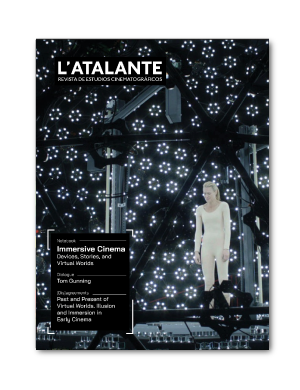From New French Extremity to the subversion of screen violence: aesthetics and discourse in Gaspar Noé’s 'I Stand Alone'
Published 2023-01-01
Keywords
- Gaspar Noé,
- Violence,
- European cinema,
- New French Extremity,
- Metadiscourse
- Spectator. ...More
How to Cite
Copyright (c) 2023 L'Atalante. Journal of film studies

This work is licensed under a Creative Commons Attribution-NonCommercial-NoDerivatives 4.0 International License.
Abstract
This article explores the discursive and aesthetic aspects of the depiction of violence in the controversial filmography of Gaspar Noé. The main object of study is his first film, I Stand Alone (Seul contre tous, 1998), understood here as the true foundation of his creative approach, before Irreversible (2002) received international recognition and prompted critics to include him in the so-called “New French Extremity” movement. Drawing on Santos Zunzunegui's concept of “filmic microanalysis”, this article examines Noé’s aggressive formal approach with the aim of identifying his unique way of subverting the traditional cinematic spectacle enshrined in the binary of sex and violence, as well as the relationship it establishes with the spectator, who is a necessary accomplice in the hypervisibility of extreme violence that has characterised the evolution of contemporary cinema.
Downloads
References
Bazin, A. (1977). <em>El cine de la crueldad</em>. Bilbao: Mensajero.<br>
Bettetini, G. (1996). <em>La conversación audiovisual</em>. Madrid: Cátedra.<br>
Beugnet, M. (2007). <em>Cinema and Sensation: French Film and the Art of Transgression</em>. Edimburgo: Edinburgh University Press.<br>
Deleuze, G. (1994). <em>La Imagen-movimiento. Estudios sobre cine 1</em>. Barcelona: Paidós.<br>
Garrido Lora, M. (2004). <em>Violencia, televisión y publicidad</em>. Sevilla: Alfar.<br>
Horeck, T., Kendall, T. (2011). <em>The New Extremism in Cinema</em>. Edimburgo: Edinburgh University Press.<br>
Imbert, G. (2006). Violencia e imaginarios sociales en el cine actual. <em>Versión, Estudios de comunicación y Política,</em> 18, 27-51. Recuperado de https://versionojs.xoc.uam.mx/index.php/version/article/view/276.<br>
Imbert, G. (2010). <em>La sociedad informe: posmodernidad, ambivalencia y juego con los límites</em>. Barcelona: Icaria.<br>
Metz, C. (2001). <em>El significante imaginario. Psicoanálisis y cine</em>. Barcelona: Paidós.<br>
Molina-Foix, V. (1995). El cine posmoderno, un nihilismo ilustrado. VVAA. <em>Historia general del cine</em>, vol. XII (pp. 151-166). Madrid: Cátedra.<br>
Mongin, O. (1999). <em>Violencia y cine contemporáneo.</em> Barcelona: Paidós.<br>
Orellana Gutiérrez de Terán, J. (2007). Cine y violencia. <em>Escuela abierta</em>, 10, 91-100. Recuperado de https://dialnet.unirioja.es/servlet/articulo?codigo=2520031.<br>
Prince, S. (2003). <em>Classical Film Violence: Designing and Regulating Brutality in Hollywood Cinema, 1930-1968</em>. New Brunswick: Rutgers University Press. <br>
Quandt, J. (2004). Flesh & Blood: Sex and Violence in Recent French Cinema. <em>ArtForum</em>. Recuperado de https://www.artforum.com/print/200402/flesh-blood-sex-and-violence-in-recent-french-cinema-6199.<br>
Sanmartín, J., Grisolía, J., Grisolía, S. (2005) (eds.). <em>Violencia, cine y televisión</em>. Barcelona: Ariel.<br>
Vasse, D. (2008). <em>Le Nouvel âge du cinéma d’auteur français</em>. París: Klincksieck.<br>
Vilaró i Moncasí, A. (2017). La sangre que esconde el cuerpo: la subversión del deseo en el cine francés contemporáneo. <em>Cédille, revista de estudios franceses</em>, 13, 501-527.<br>
https://www.ull.es/revistas/index.php/cedille/article/view/1589/1076.<br>
Zavala, L. (2012). La representación de la violencia en el cine de ficción. <em>Versión, Estudios de comunicación y política</em>, 29. Recuperado de https://versionojs.xoc.uam.mx/index.php/version/article/view/489/487.<br>
Zunzunegui, S. (1996). <em>La mirada cercana. </em>Barcelona: Paidós.</p>

